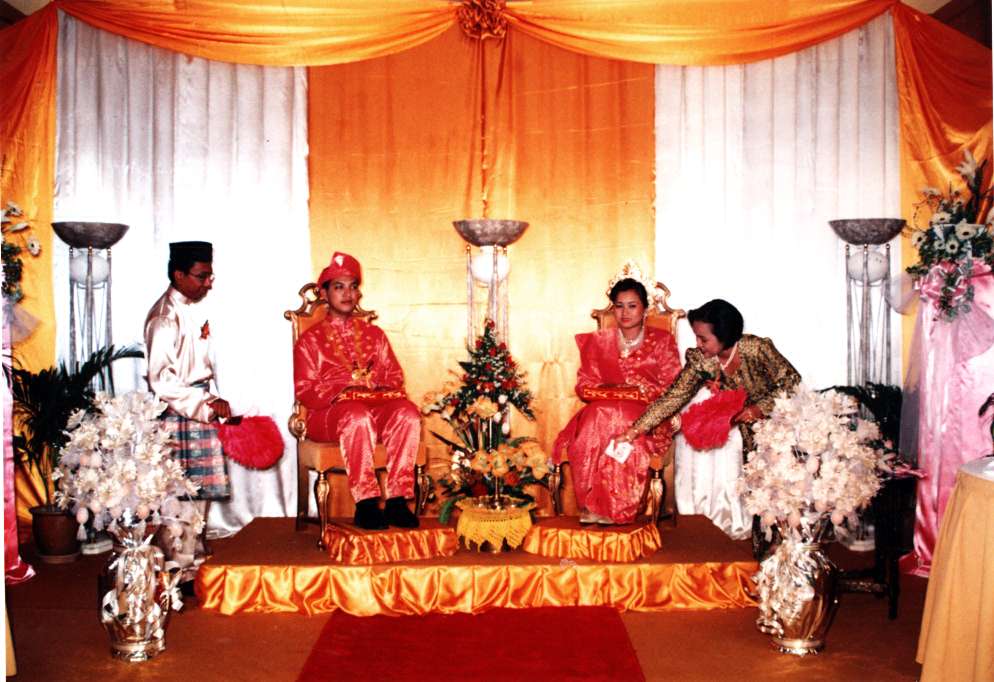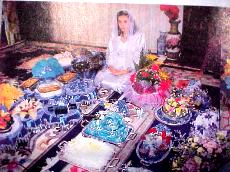Wedding Feast
During the wedding ceremony, the host will hold a feast for the guest. Regardless their status, all wedding will have the feast. The feast is not a symbol of status and it will be held according to their financial state.
The family of the host will come together to help serving the feast. It is a common practice at the village, that all the villagers will come to help the host . Some will do the cooking, buying the foods, serving and cleaning.
Common meals served are (in malay):
1) nasi minyak
2) rendang ayam/daging
3) rendang tok
4) acar
5) kari ayam/daging
6) drinksIn cities, some host will cater service from caterer and it seems to be easier because usually, the host will be very busy to handle all the stuffs. Serving starts as early as 12 pm till 5 in the evening.
Sitting in State ( Bersanding)
The highlight of the Malay wedding ceremonies is the “bersanding” or the “sitting in the state” of the bridal couple where the bride and the groom are made to sit on a gaily decorated dais as a royal couple would prior to this, the bridegroom dressed in traditional finery is led by the bestman and his party to the bride’s home, clutching a “sirih latlat” or “sirih genggam”, a bunch of betel leaves sent to him earlier by the bride’s party as an invitation. The bridegroom’s party makes its way to the bride’s residence in a slow procession, preceded by “bunga manggar” carries and a “kompang” “hadiah” or “rebana” orchestra.
The party is welcomed at the bride’s residence with the strewing of yellowrice and sprinkling of scented water and also a presentation of the “pencak silat” or Malay art of self-defence. Before being allowed into the premises, the groom’s part is made to overcome a number of humorous obstacles designed to add some fun to the occasion and to promote a congenial atmosphere. Having overcome these obstacles, the bridegroom is led to the dais to sit at the right side of the bride to begin the sitting in the state, where they are treated as king and queen for a day.
During the sitting in state, relatives, friends and well wishes come up to the dais to sprinkle yellowrice and scented water on the bridal couple after which the guest is given a “ bunga telur”.
The steps leading up to the dais are usually odd in number depending on the social status of the couple, three for ordinary folk, five for nobles and seven for royalty.
Wedding Gifts
Malay wedding which have been inherited through the ages usually begin with activities known as ‘merisik’ or making inquiry, ‘meminang’or bethoral, ‘menghantar belanja’ or sending the tokens of gifts and ‘akad nikah’ or conclusion of the marriage contract. Following agreement by the 2 sides ( the bride’s and the bridegroom’s) regarding the date of the wedding ceremony, the actual marriage takes places.
The bridegroom and his entourage will be received and warming welcome by the bride’s family and close relatives. The leader of the entourage, witness by the ‘pegawai adat’ (‘master of tradition) and the bride’s close relatives, will the hand over selected items which have been brought as gifts for the bride ; these include a ‘tepak sireh’ or the betel box complete with articles used in the chewing of betel nut.
All the gifts are specially arranged and beautifully wrapped. When everyone is satisfied that the gifts are in accordance with the earlier agreement, then the marriage contract can be concluded.
The tradition of sending the wedding gifts is a token of love from the bridegroom to his future wife. These gifts come in various form including money, a complete wedding dress, prayer mate and attire, towel, make up set , a gold or a diamond ring, traditional as well as modern Malay cakes, fruit and a wide range of flowers. The parcels usually total an odd number, for example 7,9,11 or 13, depending on the economy standing and the wishes of the bridegroom’s family.
All the wedding presents are carefully and beautifully arranged on a ‘pahar’ (a metal pedestal tray) or in containers lined with brocaded velvet or are wrapped in glittering colored paper, and give the effects of gifts for a King. The bride’s family reciprocates by sending similar gifts, but the emphasis is more on cakes, which symbolize the culinary skills and feminine attribute of prospective bride.
designed
& maintained by : Afza


